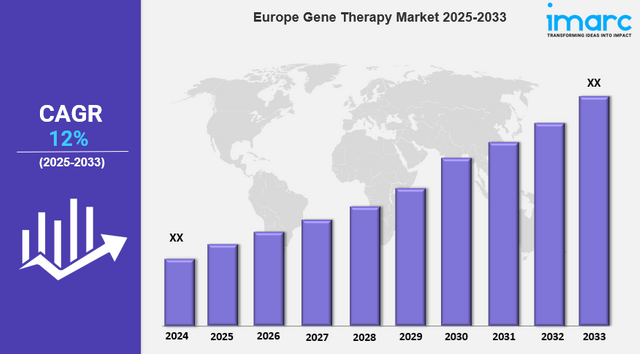Europe Gene Therapy Market Size, Growth, Trends & Opportunity Analysis 2025-2033
Market Overview 2025-2033
The Europe gene therapy market size is projected to exhibit a growth rate (CAGR) of 12% during 2025-2033. The significant advancements in gene editing technologies, escalating prevalence of genetic disorders, increasing investment in research and development (R&D) activities, and favorable regulatory policies represent some of the key factors driving the market.
Key Market Highlights:
✔️ Strong market expansion driven by advancements in biotechnology & rising healthcare awareness
✔️ Growing demand for innovative gene-based treatments for rare and chronic diseases
✔️ Increasing focus on regulatory support and streamlined approval processes
Request for a sample copy of this report: https://www.imarcgroup.com/europe-gene-therapy-market/requestsample
Europe Gene Therapy Market Trends and Drivers:
The Europe gene therapy market in 2025 is witnessing significant growth, fueled by rapid advancements in gene editing technologies such as CRISPR-Cas9, TALENs, and zinc finger nucleases. These cutting-edge tools are revolutionizing the treatment landscape by offering precise and targeted modifications to genetic material, addressing the root causes of genetic disorders rather than just managing symptoms. The increasing adoption of gene editing in research and clinical applications is accelerating the development of personalized therapies for conditions such as cystic fibrosis, hemophilia, and certain types of cancers.
Additionally, collaborations between biotech firms, research institutions, and pharmaceutical giants are fostering innovation and expediting clinical trials. As Europe remains at the forefront of regulatory frameworks ensuring the safety and efficacy of gene-based treatments, the region is emerging as a hub for pioneering advancements in genomic medicine. With continuous technological progress and increasing investment in R&D, gene therapy is poised to become a mainstream treatment option, reshaping the future of medicine in Europe.
The demand for gene therapy in Europe is surging as it offers a transformative approach to treating rare and chronic diseases that have limited or no existing treatment options. Conditions such as spinal muscular atrophy (SMA), sickle cell disease, and inherited retinal disorders are now seeing promising advancements through gene-based interventions. The European Medicines Agency (EMA) has been actively approving novel gene therapies, facilitating quicker access for patients with life-threatening genetic conditions. Additionally, the rise in awareness about gene therapy among healthcare providers and patients is driving market expansion, with many seeking long-term or even curative treatment alternatives over traditional pharmaceutical options.
As the prevalence of genetic disorders and chronic diseases continues to grow, the demand for gene therapy is expected to increase significantly, leading to further investments in biotechnology and clinical research. This trend is also encouraging government bodies and private investors to support the development and commercialization of innovative therapies, fostering an environment of medical breakthroughs in the region.
The Europe gene therapy market is experiencing significant expansion in manufacturing capabilities and regulatory frameworks, ensuring efficient production and safe market entry for gene-based treatments. With the increasing number of gene therapies receiving approval, the need for scalable and cost-effective manufacturing solutions has become a top priority. Companies are investing heavily in advanced biomanufacturing facilities to produce viral vectors, cell-based therapies, and other essential components required for gene therapy. At the same time, European regulatory agencies are streamlining approval processes to accelerate patient access while maintaining high safety and efficacy standards.
Harmonization of policies across the European Union, combined with incentives for biotech firms, is encouraging further innovation and commercialization. Additionally, partnerships between academia, pharmaceutical companies, and contract development organizations (CDMOs) are enhancing production efficiency and reducing costs. As the gene therapy sector matures, improved regulatory clarity and enhanced manufacturing infrastructure will play a critical role in driving market growth, ensuring broader accessibility of these groundbreaking treatments across Europe.
Europe Gene Therapy Industry Segmentation:
The report segments the market based on product type, distribution channel, and region:
Study Period:
Base Year: 2024
Historical Year: 2019-2024
Forecast Year: 2025-2033
Gene Type Insights:
- Antigen
- Cytokine
- Tumor Suppressor
- Suicide Gene
- Deficiency
- Growth Factors
- Receptors
- Others
Vector Type Insights:
- Viral Vector
- Adenoviruses
- Lentiviruses
- Retroviruses
- Adeno-Associated Virus
- Herpes Simplex Virus
- Poxvirus
- Vaccinia Virus
- Others
- Non-Viral Techniques
- Naked and Plasmid Vectors
- Gene Gun
- Electroporation
- Lipofection
- Others
Delivery Method Insights:
- In-Vivo Gene Therapy
- Ex-Vivo Gene Therapy
Application Insights:
- Oncological Disorders
- Rare Diseases
- Cardiovascular Diseases
- Neurological Disorders
- Infectious Disease
- Others
Country Insights:
- Germany
- France
- United Kingdom
- Italy
- Spain
- Others
Competitive Landscape:
The report offers an in-depth examination of the competitive landscape. It includes a thorough competitive analysis encompassing market structure, key player positioning, leading strategies for success, a competitive dashboard, and a company evaluation quadrant.
Contact Us:
IMARC Group
134 N 4th St. Brooklyn, NY 11249, USA
Email: [email protected]
Tel No:(D) +91 120 433 0800
United States: +1-631-791-1145
